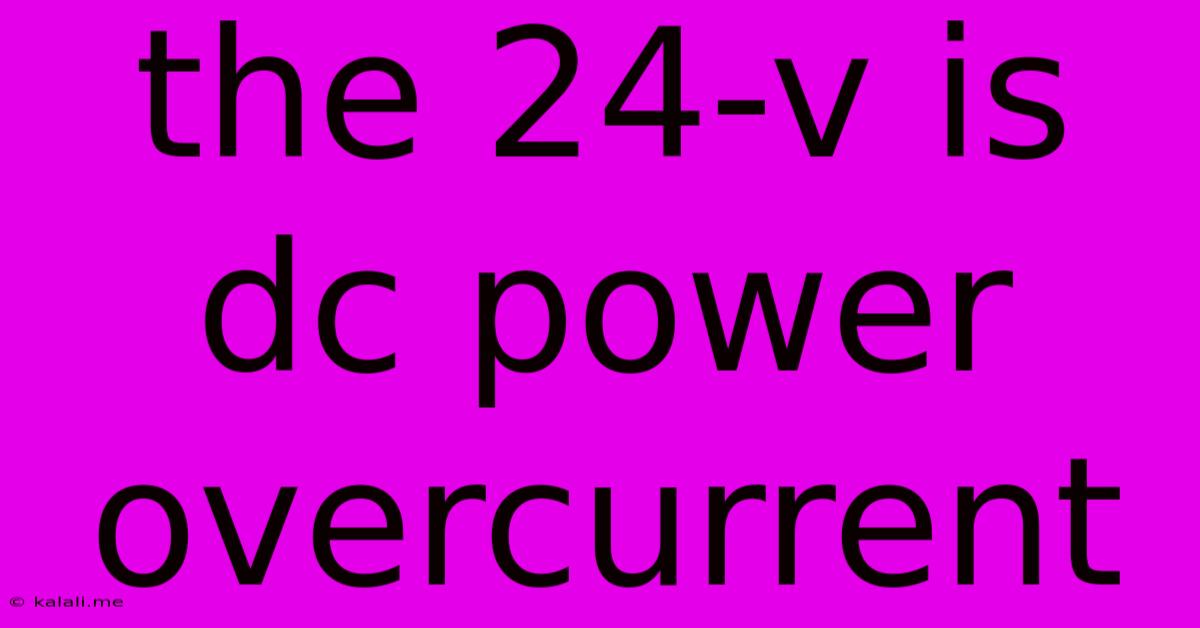The 24-v Is Dc Power Overcurrent
Kalali
Jun 03, 2025 · 3 min read

Table of Contents
Understanding 24V DC Power Overcurrent: Causes, Prevention, and Solutions
Meta Description: This article explains the causes of 24V DC power overcurrent, preventative measures to avoid it, and troubleshooting steps to resolve the issue. We cover short circuits, overload conditions, and faulty components.
24V DC power supplies are common in various applications, from industrial automation to electronic devices. However, experiencing a 24V DC power overcurrent situation can be disruptive and potentially damaging. Understanding the root causes and implementing preventative measures are crucial for maintaining a stable and safe power system. This article explores the common causes of 24V DC power overcurrents, effective strategies to prevent them, and troubleshooting techniques to resolve the problem.
What is a 24V DC Power Overcurrent?
A 24V DC power overcurrent occurs when the current flowing through a circuit exceeds its designed capacity. This usually trips a protective device like a fuse or circuit breaker, halting the power flow to prevent damage to components or even fire hazards. The overcurrent signifies a problem within the electrical system that needs immediate attention.
Common Causes of 24V DC Power Overcurrent
Several factors can contribute to a 24V DC power overcurrent:
-
Short Circuits: This is perhaps the most common cause. A short circuit occurs when there's an unintended low-resistance path between the positive and negative terminals of the power supply. This allows excessive current to flow, quickly exceeding the circuit's capacity. Damaged wiring, loose connections, or internal component failures are typical culprits.
-
Overload Conditions: Connecting too many devices or loads to a single circuit can cause an overload. Each device draws a certain amount of current, and if the total current demand surpasses the circuit's rating, an overcurrent occurs. This is often seen in systems with multiple actuators, motors, or other power-hungry components.
-
Faulty Components: A malfunctioning component, such as a shorted motor, a defective power supply, or a damaged electronic controller, can draw excessive current, leading to an overcurrent condition. Regular maintenance and inspection can help identify and replace these components before they cause a major problem.
-
Improper Wiring: Incorrect wiring practices, including using undersized wires or loose connections, increase the resistance of the circuit and can lead to overheating and eventual overcurrent. Always adhere to recommended wiring standards and practices.
Preventing 24V DC Power Overcurrent
Proactive measures can significantly reduce the risk of overcurrent events:
-
Regular Inspection and Maintenance: Regularly inspect wiring, connectors, and components for signs of damage or wear. Tighten loose connections and replace any faulty parts promptly.
-
Proper Fuse and Circuit Breaker Selection: Choose fuses and circuit breakers with the appropriate amperage rating for the specific circuit to protect against overcurrent conditions.
-
Load Balancing: Distribute the load across multiple circuits to prevent overloading any single circuit. Avoid connecting too many high-current devices to a single power source.
-
Using appropriately rated components: Make sure that all components such as wires, connectors, and circuit breakers are rated for the current and voltage levels of your system. Avoid overloading individual components.
-
Quality Control in Design and Installation: Employing proper design and installation practices from the outset is critical to prevent future overcurrent issues. This includes careful planning and the use of high-quality materials.
Troubleshooting 24V DC Power Overcurrent
If an overcurrent occurs, follow these troubleshooting steps:
-
Isolate the Problem: Turn off the power supply immediately. Carefully inspect the wiring, connectors, and components for any visible signs of damage, such as burns, melting, or loose connections.
-
Check Fuses and Circuit Breakers: Replace blown fuses or reset tripped circuit breakers. If the overcurrent persists after replacing the fuse or resetting the breaker, there's a more significant problem in the circuit.
-
Systematic Component Testing: Use a multimeter to check the current draw of individual components to identify the faulty element causing the overcurrent.
-
Professional Assistance: If you are unable to identify and rectify the problem, it is best to consult a qualified electrician or technician.
By understanding the causes, implementing preventative measures, and following proper troubleshooting procedures, you can effectively manage and mitigate 24V DC power overcurrent issues, ensuring the safe and reliable operation of your system. Remember, safety should always be the priority.
Latest Posts
Latest Posts
-
How To Make Crickets Shut Up
Jun 04, 2025
-
Can You Fix A Fiberglass Tub
Jun 04, 2025
-
1 Universal Mass Unit Eual To
Jun 04, 2025
-
03 Honda Accord Power Steering Fluid
Jun 04, 2025
-
Why Does My Gas Fireplace Keep Shutting Off
Jun 04, 2025
Related Post
Thank you for visiting our website which covers about The 24-v Is Dc Power Overcurrent . We hope the information provided has been useful to you. Feel free to contact us if you have any questions or need further assistance. See you next time and don't miss to bookmark.